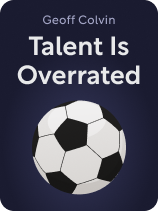

This article is an excerpt from the Shortform book guide to "Talent Is Overrated" by Geoff Colvin. Shortform has the world's best summaries and analyses of books you should be reading.
Like this article? Sign up for a free trial here.
How can you develop your weaknesses into strengths? What does it take to strengthen your skills?
Improving weaknesses and developing strengths requires not only seeing where you’re doing well but also being able to self-criticize and find weak points that you can develop into strengths. You can do this with a simple four-step process.
Learn how to walk through this process and get better at anything.
Step #1: Identify the Weak Point You Want to Improve
The first step in improving weaknesses is to identify a specific weak point to focus on. You can’t work on more than one weak point at a time because it would be difficult to track your technique and progress properly. If you’re moving erratically between weak points and techniques, you can’t be certain which of them actually improved your performance—thus, you can’t replicate that improvement or move on to solving the next issue. In contrast, devoting your energy and time to excelling at one aspect of your field lets you accurately identify which techniques improve your performance and correct weak points in a steady, consistent process of developing strengths.
To choose a weak point, first choose a task you need to complete. Then, determine which skills help you complete that task. Finally, identify which of those skills needs the most improvement—which skill you’re worst at. Returning to our manager example, the skills that help you give feedback to your team members are active listening and clear communication. If you’re already an active listener but you struggle to articulate your thoughts, you most need to develop clarity. Thus, you decide to focus on improving that weak point.
(Shortform note: When choosing which task to work on, it may be helpful to use the assessment and prioritization method outlined by Jeff Sutherland in Scrum. Make a list of your tasks and then identify which of them will generate the most value in the least amount of time. That’s the most important task, so you should complete it first. Arguably, you could then apply this method to identify the skill you should focus on. First, make a list of skills relevant to the task. Then, identify which skill you’re worst at that will best help you complete the task.)
| Deliberate Practice and the Scientific Method This approach to tackling weak points one at a time mirrors the scientific method, which scientists use to develop and test hypotheses. In addition to isolating one element of an experiment so you can accurately understand cause and effect, the scientific method requires that you control for bias—that you don’t let your own opinions or desires influence your interpretation of the results. You may need to control for bias in deliberate practice, too. For instance, you may be biased toward seeing progress where there isn’t any. If you believe that you’ve sufficiently improved your weak point, you may move on to another one prematurely. Scientists control for bias by having other scientists replicate their experiments and seeing if the results match. Since deliberate practice is personalized to your specific tasks and weak points, though, this method may not work here. Instead, you could potentially control for bias by asking your peers for feedback: If they agree that you’re improving in your chosen skill, you know that you’re actually making progress, instead of simply seeing improvement because you want to see it. |
Step #2: Create an Improvement Plan
Once you’ve chosen a weak point, you must create a plan for how you’ll improve that weak point while completing your task. This helps you commit: You know exactly what you need to do, so you can focus on performing the skill to the best of your ability. (Shortform note: As well as helping you commit, some management experts say making plans can increase adaptability and ensure you use resources effectively. However, they caution against becoming too fixated on a plan: Monitor how well the plan is working and be ready to adjust it if necessary.)
To create this plan, consider the process you usually use when completing your task. Then, set a specific goal for what you’ll do differently to practice your chosen skill. For example, your normal process for giving feedback might be to briefly outline all your feedback and then ask your subordinate if they have any questions. You only go into more detail about the points they ask questions about. Instead, you might decide to practice clarity by discussing each point in more detail from the beginning. Specifically, you decide to devote at least five minutes to discussing each feedback point and to include an example of each in your discussion (if you praise their leadership, you’ll share an example of a time they were a strong leader).
| How to Set Specific Goals You should set specific goals because they’re more motivating, some productivity experts say. To set a specific goal, answer five questions: 1. What’s my goal? 2. Why does my goal matter? 3. Who’s involved in my efforts to complete my goal? 4. Where do I have to go to complete my goal? 5. Which resources or limits do I have in completing my goal? When setting a goal for how you’ll complete your task differently, you may want to analyze your strengths as well as your weak spot. Finding a way to use your strengths to improve your weak spot can help you overcome the discomfort of confronting your weaknesses, some psychology experts say. To do this, make a list of your strengths and then highlight the ones that could help you overcome your chosen weak spot. Continuing our example, your strength might be keeping meticulously organized records. You can use those records to find relevant examples that boost your clarity. You could also keep a record of how your team members react to your new feedback methods, so you can track your progress. |
Step #3: Analyze Your Performance
Next, analyze your performance. Analyzing how well you completed your task gives you the feedback needed to adjust your process and become more successful in the future. One way to do this is to compare your performance to someone who’s slightly better at your chosen skill. This pushes you to improve without setting the standard so high that it’s impossible to reach and becomes discouraging. Then, walk back through your plan and identify ways your performance falls short of that standard and how you can avoid that in the future.
For instance, if your manager is a clear communicator, you may compare how they provide feedback to your own method. You realize that your manager spends 10 minutes discussing each feedback point, instead of five, and you adjust your plans accordingly.
| Another Way to Analyze Your Performance Brian Moran offers another analysis method in The 12 Week Year. He says to give yourself 12 weeks to meet a goal, measuring your progress every week. To do this, you’ll track lag indicators and lead indicators. Lag indicators measure results, while lead indicators measure the steps taken to achieve those results. In our example, the lag indicator is your level of clarity, and the lead indicator is how much of your improvement plan you completed. You want to have a high success rate in both indicators to complete your improvement plan and be much clearer as a result. However, Moran says that having a high weekly success rate in just one indicator means you’re making progress, and that you can have a success rate as low as 65% and still succeed in your overall goals if you work progressively harder. This leeway may make your goals more motivating, as you’re not reaching for the impossible standard of perfection and thus are less likely to become discouraged. If you don’t have a high success rate in one or both measures, Moran suggests walking back through your plan to determine why your performance fell short. However, Moran adds that the problem may not be with your plan, but with your execution of it. If you didn’t execute your plan to the best of your ability, you may not need to adjust it. In those cases, change your behavior by trying harder to execute the plan properly. |
Step #4: Adjust Your Improvement Plan and Repeat
Finally, adjust your improvement plan with the feedback you gained in Step #3 and then repeat it. This step turns your deliberate practice into a virtuous cycle, allowing you to continue gathering more information and gradually improving your performance.
For example, in Step #3, you realized that you still weren’t spending enough time on each feedback point, so you adjusted your plan to spend 10 minutes on each. However, at your next feedback session, you run out of time before you can discuss each of your feedback points. You once again compare your performance to your manager’s and realize that your manager may discuss each point for longer, but they also discuss fewer points overall. Thus, for your next attempt, you decide to identify the four most important feedback points, so you can discuss them in detail without running out of time.(
Shortform note: To achieve this virtuous cycle, you must be willing to continually change your improvement plan as you gather more information and refine your methods. Thus, some career experts’ advice on being adaptable may be helpful. First, stay positive. Instead of being upset that your plan wasn’t perfect, focus on the chance you have to improve. Second, focus on your ultimate goal. The desire to achieve it—in this case, to perform excellently—can help you accept change. Finally, remember that change is inevitable—and, in your case, good because it helps you continually improve. This can reduce frustration and prepare you to adapt in the future.)

———End of Preview———
Like what you just read? Read the rest of the world's best book summary and analysis of Geoff Colvin's "Talent Is Overrated" at Shortform.
Here's what you'll find in our full Talent Is Overrated summary:
- How some people can perform at a globally impressive level while the average person can't
- Why you need to shift your mindset from talent to training
- How to use the two approaches to deliberate practice successfully






